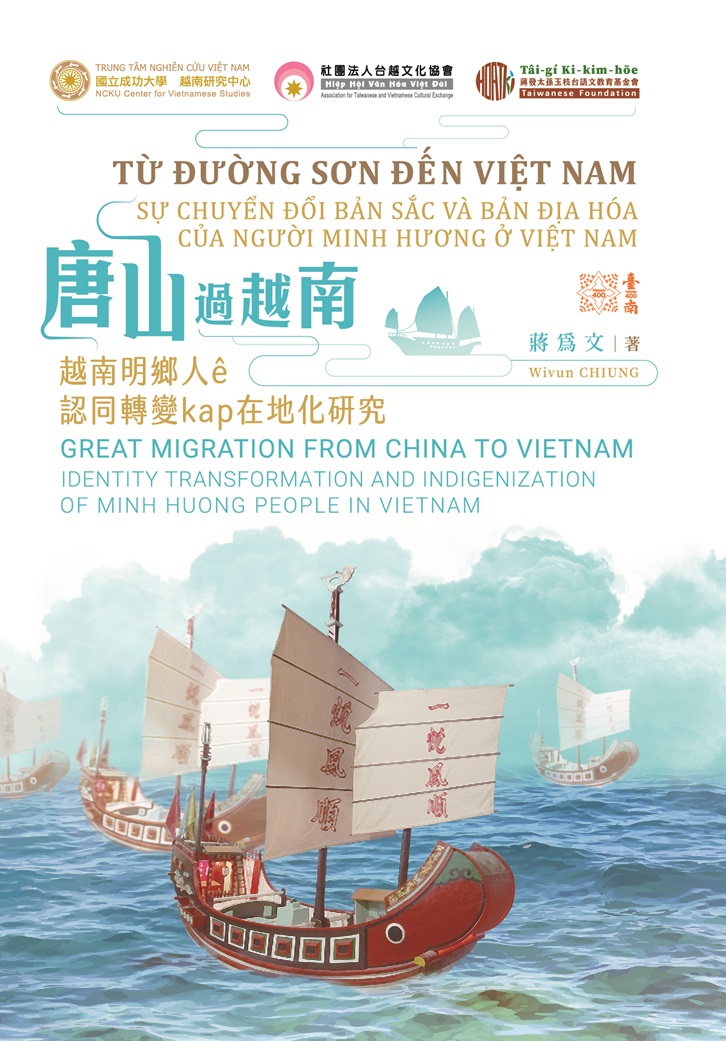國立成功大學 越南研究中心

TỪ ĐƯỜNG SƠN ĐẾN VIỆT NAM: SỰ CHUYỂN ĐỔI BẢN SẮC VÀ BẢN ĐỊA HÓA
CỦA NGƯỜI MINH HƯƠNG Ở VIỆT NAM
唐山過越南:越南明鄉人之認同轉變與在地化研究 sample見本
GREAT MIGRATION FROM CHINA TO VIETNAM: IDENTITY TRANSFORMATION AND INDIGENIZATION
OF MINH HUONG PEOPLE IN VIETNAM
蔣為文(Wivun CHIUNG) 著
關於本書
本書從文化人類學的角度探討十七世紀以來唐人從中國移民到越南後在地化成明鄉人並進一步成為越南人的認同轉變過程。鄭成功的舊屬「陳上川」曾率兵三千餘人投靠越南的阮氏政權。這些不願被滿清統治的明朝遺民最後落腳越南,大多數均與當地越南女子通婚而在地化成為「明鄉人」。「有唐山公,無唐山媽」這句台語不僅源自台灣,也適用在越南的明鄉人。越南明鄉人就如同明鄭時期流亡到台灣的唐山公,經由通婚及在地化過程,已落地生根成為新越南人。
推薦人
國立台灣文學館 前館長鄭邦鎮教授推薦
鄭成功的三千名舊屬移民到越南後落地生根成越南人之雙贏案例可做為台灣處理二戰後移民之重要參考。
國立台灣師範大學台灣史研究所所長康培德教授推薦
Tn̂g-soaⁿ kòe Oa̍t-lâm, chhut-iûⁿ chò Tn̂g-lâng, hoan-thâu tńg bô lō͘, lo̍h-tē lâi seng thòaⁿ.
台灣教授協會秘書長 中央研究院近史所退休 許文堂教授推薦
不僅是了解明末移民到越南和台灣的最佳入門,也成功呈現1949年中國難民四散流亡的對照,是一本同時能理解越南、台灣的好書。
澳洲Monash大學中國研究兼任研究員許建榮博士推薦
唐山人為了生存移民四方,卻常有落葉歸根的思維。也是來自唐山的明鄉人,為了生存在越南落地生根,這才是「食果子拜樹頭,食米飯拜田頭」,真正的飲水思源。
日本大阪大學越南學系 清水政明教授推薦
本著作はベトナム語と台湾語の双方に精通した著者による他に類を見ない貴重なものである。

This book explores the identity transformation of the Chinese who immigrated from China to Vietnam in the 17th century after the fall of the Ming Empire in China. Some former subordinates of Koxinga, such as Trần Thượng Xuyên (陳上川) brought three thousand soldiers to Vietnam. Most of them intermarried with the local Vietnamese women. They identified themselves as Minh Huong People (明鄉人) and finally as Vietnamese people. In this book, a lot of Minh Huong Assembly Halls and Chinese Assembly Halls in Vietnam were investigated. ‘Long Phi’ (龍飛) and ‘Long Tập’ (龍集) were two era names originally fabricated by Minh Huong People. In Vietnam, Long Phi is found much more commonly than Long Tập. In this study, 84 pieces were written with Long Phi, and only two were Long Tập. Per the relics found, the earliest Long Phi could be traced back to 1663, and the latest year as late as 1936, after the fall of Qing Empire in China. It reveals that Long Phi has gradually become a spiritual symbol rather than “opposing Qing to restore Ming” for the Minh Huong People after they have settled in Vietnam for generations.


